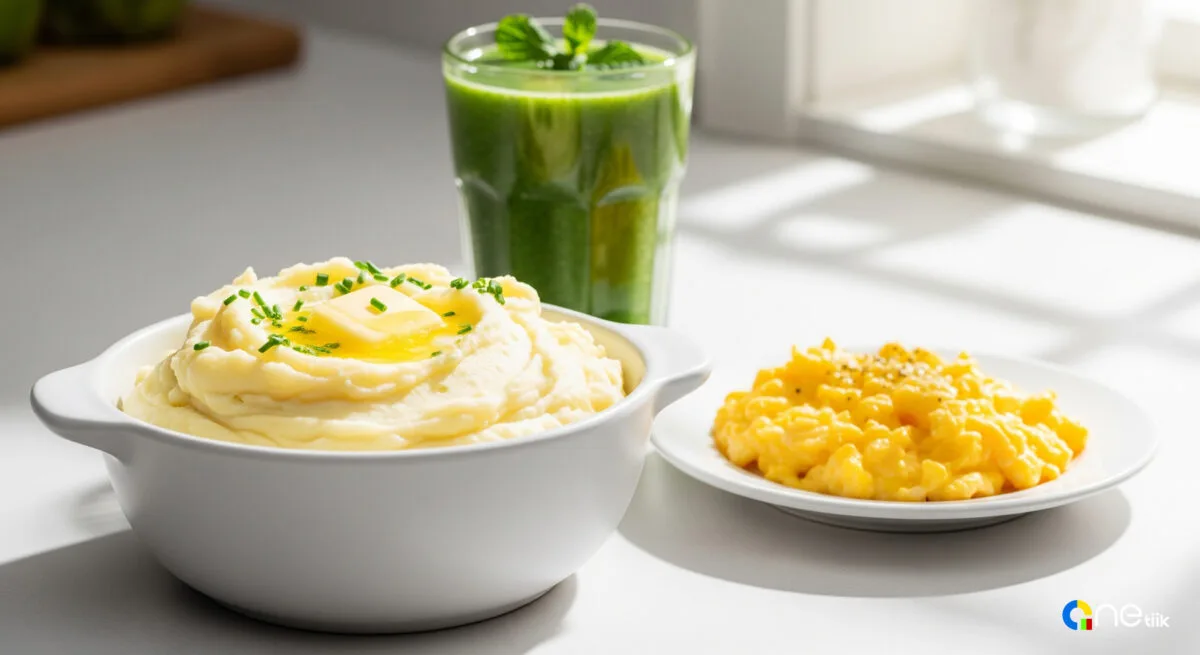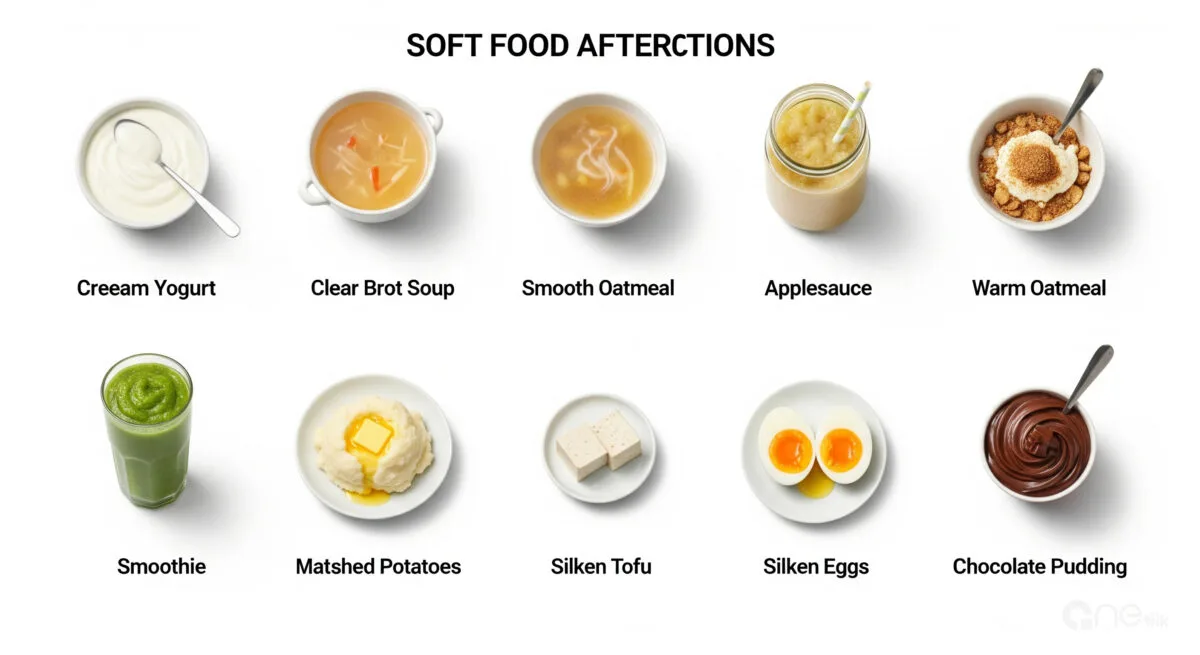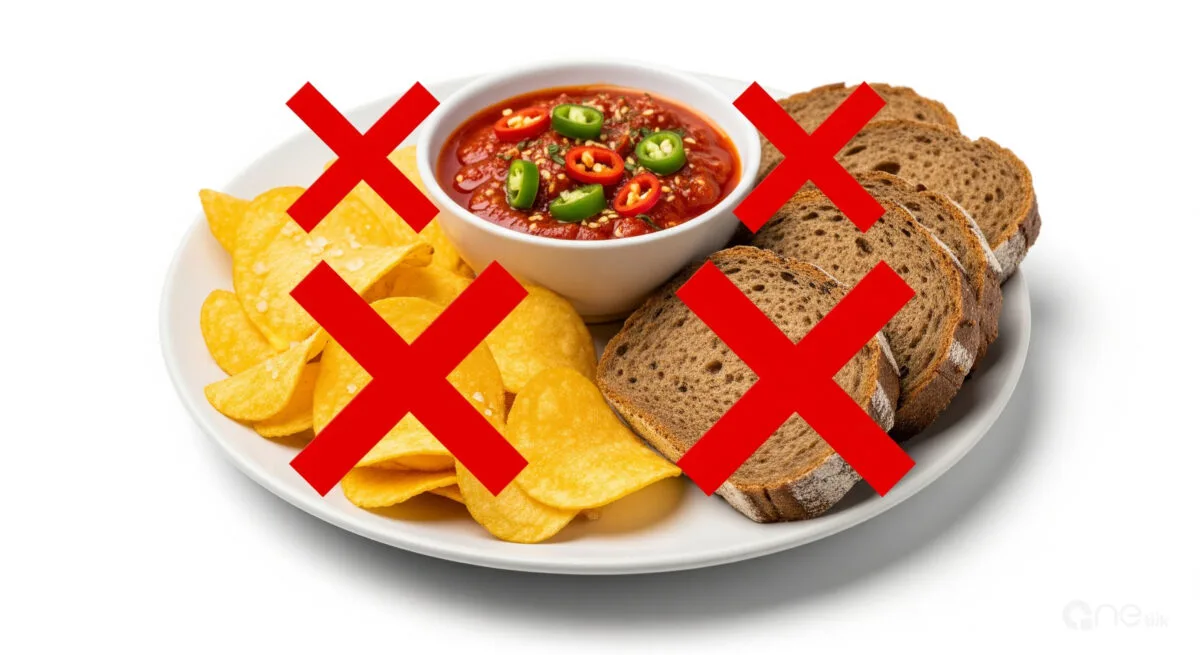Introduction
Getting the right soft foods after tooth extraction can make all the difference in how quickly you heal and how comfortably you recover. Choosing gentle, easy-to-chew options not only soothes sore gums but also protects the blood clot that’s key to preventing complications like dry socket. In this guide on soft foods to eat after tooth extraction, we’ll help you find the best soft foods after oral surgery so you can focus on healing, not on what’s on your plate.
This article is designed for anyone who’s just had a tooth pulled, whether it was a simple extraction, wisdom-tooth removal, or more extensive oral surgery. If you’ve ever wondered, “What can I eat after mouth surgery?” or “Which post-dental surgery foods are both tasty and safe?” you’re in the right place.
By the end of this page, you’ll know:
- A clear eating timeline: What to eat on days 0–1, 2–4, 5–7, and beyond
- Top 50 soft foods: From creamy yogurts and mashed potatoes to blended soups and protein shakes
- Easy recipes & prep tips: How to blend, strain, and season for both flavor and nutrition
- Foods to avoid: Hard, crunchy, spicy, or acidic items that can irritate your healing gums
Let’s dive in and make your post-extraction diet simple, satisfying, and super supportive of your body’s natural repair process.
Understanding Your Post-Extraction Diet

When you’re recovering from a tooth extraction or any oral surgery, what you eat is just as important as how you care for your wound. A gentle, soft-food diet supports healing, keeps you comfortable, and helps you get the nutrients your body needs. Let’s look at why sticking to soft foods matters—and how to phase in different textures as your mouth feels better.
2.1 Why a Soft-Food Diet Matters
- Protects the blood clot
After extraction, a stable blood clot seals the socket. Chewing hard or crunchy foods can dislodge that clot, leading to painful dry socket. - Eases chewing and swallowing
Soft, smooth foods like mashed potatoes or yogurt glide over tender gums. You avoid extra pressure on the surgical site and reduce the risk of irritation. - Supports good nutrition
Just because you’re eating “soft” doesn’t mean skimping on protein, vitamins, or minerals. Blended soups, protein shakes, and pureed legumes all count as post-dental-surgery food that fuels recovery. - Reduces discomfort and swelling
Lukewarm or chilled soft foods help calm inflammation—cold applesauce or a creamy smoothie can feel soothing on the gums.
By choosing the best soft foods after oral surgery, you make it easier for your body to focus on healing and less on fighting off infection or pain.
2.2 Timeline: What to Eat and When
| Days After Extraction | Texture & Consistency | Examples |
|---|---|---|
| 0–1 | Clear liquids & very thin purees | Broth, apple juice, ice chips |
| 2–4 | Smooth purees & milkshakes | Plain yogurt, mashed potatoes, protein shakes |
| 5–7 | Soft but chunk-free foods | Scrambled eggs, smooth oatmeal, cottage cheese |
| 8+ | Gentle soft solids | Soft pasta, well-cooked steamed veggies (blended if needed) |
- Days 0–1: Stick with clear liquids and thin purees—this helps you stay hydrated without stressing your gums.
- Days 2–4: You can introduce thicker purees and milkshakes. Aim for soft foods to eat after tooth extraction that pack protein and calories.
- Days 5–7: As swelling eases, add in soft solids that require minimal chewing.
- After Day 8: You’re usually ready for gently cooked vegetables, soft pasta, and other tender foods—just still skip anything crunchy or sticky.
Following this eating timeline ensures you get essential nutrients while protecting your healing socket. Next up, we’ll dive into 50 specific soft foods that fit perfectly into each phase of your recovery.
Top 50 Soft Foods by Category
Below are 50 gentle, easy-to-chew options, perfect soft foods to eat after tooth extraction or any post-dental surgery food plan. Each item includes a quick tip and its healing benefit.

Dairy & Eggs (10)
- Plain yogurt
- Tip: Choose unsweetened Greek yogurt for extra protein.
- Benefit: Probiotics support gut health and immunity.
- Cottage cheese
- Tip: Blend until super-smooth if curds feel too lumpy.
- Benefit: Good source of calcium and protein.
- Milkshakes
- Tip: Use protein-enriched powder and avoid seeds or nuts.
- Benefit: Easy calories + protein boost.
- Scrambled eggs
- Tip: Whisk well and cook low-and-slow for soft curds.
- Benefit: Complete protein for tissue repair.
- Poached eggs
- Tip: Simmer gently in water with a splash of vinegar.
- Benefit: Soft texture with minimal added fat.
- Soft cheese spreads
- Tip: Mix with a little milk to thin out if needed.
- Benefit: Adds flavor and calcium.
- Kefir
- Tip: Sip slowly or blend into smoothies.
- Benefit: Probiotic-rich for digestion.
- Ricotta cheese
- Tip: Stir in a bit of honey or mashed fruit.
- Benefit: Mild, creamy, and high in protein.
- Custard
- Tip: Cool to lukewarm to avoid sensitivity.
- Benefit: Comforting dessert with calcium.
- Soft-boiled eggs
- Tip: Cook 5–6 minutes so yolk stays runny.
- Benefit: Tender whites plus nourishing yolk.
Proteins & Legumes (10)
- Silken tofu puree
- Tip: Blend with a bit of broth for extra flavor.
- Benefit: Plant-based protein, super soft.
- Blended lentil soup
- Tip: Strain after cooking for a silky texture.
- Benefit: Fiber and iron for healing.
- Smooth hummus
- Tip: Remove chickpea skins and blend extra long.
- Benefit: Healthy fats + protein.
- Protein shakes
- Tip: Use whey or pea protein; avoid seeds.
- Benefit: Quick muscle-repair nutrition.
- Refried beans
- Tip: Mash thoroughly and add broth if too thick.
- Benefit: Fiber and plant protein.
- Greek yogurt dip
- Tip: Mix in mashed avocado or pureed veggies.
- Benefit: Flavorful way to get protein.
- Canned salmon or tuna (flaked)
- Tip: Mix with mayo or yogurt for creaminess.
- Benefit: Omega-3s and protein.
- Egg salad (mashed)
- Tip: Chop eggs very fine and bind with Greek yogurt.
- Benefit: Easy protein, good fat.
- Silky black bean puree
- Tip: Cook beans extra soft, then blend.
- Benefit: Iron-rich and filling.
- Pea soup (pureed)
- Tip: Sieve for a smoother consistency.
- Benefit: Vitamins A & C for immune support.
Grains & Starches (10)
- Mashed potatoes
- Tip: Use chicken or vegetable broth instead of milk for flavor.
- Benefit: Comforting carbs + potassium.
- Cream of wheat
- Tip: Cook until very soft; stir in a scoop of yogurt.
- Benefit: Gentle on gums with iron fortification.
- Oatmeal
- Tip: Cook with extra water or milk until soupy.
- Benefit: Fiber for digestion.
- Polenta
- Tip: Whisk in cheese or pureed veggies for nutrition.
- Benefit: Gentle grains with vitamin B.
- Rice pudding
- Tip: Make it extra creamy by using whole milk or coconut milk.
- Benefit: Soothing dessert with calcium.
- Soft pasta
- Tip: Overcook by a minute for added tenderness.
- Benefit: Easy carbohydrates to sustain energy.
- Well-cooked quinoa
- Tip: Rinse thoroughly and cook until very soft.
- Benefit: Complete plant protein + fiber.
- Soft-cooked polenta porridge
- Tip: Thin with broth for a soup-like feel.
- Benefit: Warming, gluten-free carb.
- Grits (well-cooked)
- Tip: Stir constantly to avoid lumps.
- Benefit: Smooth, comforting starch.
- Dalia (broken wheat porridge)
- Tip: Cook with extra water until creamy.
- Benefit: Whole-grain fiber.
Fruits & Vegetables (10)
- Applesauce
- Tip: Choose unsweetened or make at home.
- Benefit: Gentle fiber + vitamin C.
- Mashed bananas
- Tip: Stir in a dash of cinnamon for taste.
- Benefit: Potassium and natural sweetness.
- Avocado mash
- Tip: Add a squeeze of lime juice to prevent browning.
- Benefit: Healthy fats and vitamins.
- Pureed carrots
- Tip: Steam until very soft, then blend.
- Benefit: Beta-carotene for immunity.
- Pureed pumpkin soup
- Tip: Thin with broth and season lightly.
- Benefit: Vitamin A and potassium.
- Steamed zucchini puree
- Tip: Remove seeds, steam well, then blend.
- Benefit: Hydrating, low-acid veggie.
- Soft-cooked spinach (blended)
- Tip: Squeeze out excess water before blending.
- Benefit: Iron and folate.
- Pear purée
- Tip: Cook pears until mushy, then blend.
- Benefit: Gentle fruit fiber.
- Steamed sweet potato mash
- Tip: Add a little olive oil for smoothness.
- Benefit: Vitamin A and complex carbs.
- Smooth tomato soup
- Tip: Use low-acid tomatoes and strain seeds.
- Benefit: Lycopene is for antioxidant.
Liquids & Desserts (10)
- Clear broths
- Tip: Sip slowly; avoid very hot temperatures.
- Benefit: Hydration + electrolytes.
- Blended vegetable soups
- Tip: Strain for a silky finish.
- Benefit: Nutrient-packed and soothing.
- Jell-O and gelatin desserts
- Tip: Chill fully for best texture.
- Benefit: Gentle sweetness, easy on gums.
- Pudding (chocolate or vanilla)
- Tip: Make homemade to control sugar.
- Benefit: Calcium-rich dessert.
- Smoothie bowls (without seeds)
- Tip: Blend fruits with yogurt or milk until thick yet smooth.
- Benefit: Vitamins and protein.
- Ice-cream (soft-serve)
- Tip: Let melt slightly to avoid sensitivity.
- Benefit: Cold relief for swelling.
- Fruit nectar (strained)
- Tip: Choose low-acid fruits like a pear or a melon.
- Benefit: Gentle hydration and natural sugars.
- Bone broth
- Tip: Cool slightly to remove excess fat on top.
- Benefit: Collagen and minerals for healing.
- Herbal teas (lukewarm)
- Tip: Chamomile or peppermint; no citrus teas.
- Benefit: Calming and anti-inflammatory.
- Flavored water (infused)
- Tip: Infuse with cucumber or mint; skip citrus.
- Benefit: Tasty hydration without acidity.
Each of these soft food suggestions after oral surgery is chosen to be gentle on your healing gums, easy to prepare, and rich in the nutrients that speed recovery.
Recipe Ideas & Preparation Tips
Making soft foods that taste great and heal well doesn’t have to be complicated. These simple recipe ideas and prep tricks will help you enjoy tasty, soft foods to eat after tooth extraction while keeping your gums safe and comfortable.
Flavor Boosters
- Herb Infusions: Add a sprig of fresh basil, parsley, or cilantro to blended soups or purees. Blend in at the end for a burst of freshness without grit.
- Low-Acid Fruit Purees: Mash or blend ripe banana, steamed pear, or cooked apple for a naturally sweet side dish. Stir in a pinch of cinnamon or a drop of vanilla extract—no chunks, no irritation.
- Savory Drizzles: Finish mashed potatoes or polenta with a teaspoon of olive oil or a swirl of mild pesto. This extra fat helps nutrients absorb and adds a gentle flavor.
Texture Tricks
- Blending & Straining
- Cook vegetables or legumes until very soft.
- Blend with a little cooking liquid (broth, milk, or water) until silky.
- If you feel any tiny bits, pass the puree through a fine-mesh sieve or chinois for ultra-smooth consistency.
- Layering Textures
- Start with a smooth base (e.g., pureed carrot soup), then top with a spoonful of Greek yogurt or cottage cheese. The contrast feels interesting on your tongue but is still gentle on your gums.
- Thinning vs. Thickening
- Too Thick? Add warm broth or milk one tablespoon at a time.
- Too Thin? Cook down gently on low heat, stirring often to concentrate flavors and texture.
Temperature Tips
- Lukewarm is Best: Foods served slightly below room temperature minimize sensitivity. Avoid extremes—very hot or ice-cold can trigger discomfort.
- Chilled Comfort: For swelling, small servings of room-temperature applesauce or slightly melted ice cream can feel soothing. Don’t bite—the gentle cold numbs tender areas.
- Reheat Gently: If microwaving, stir halfway and test with a fingertip before eating. Aim for a cozy, not scorching, temperature.
Quick Recipe Ideas
- Creamy Pumpkin Soup
- Ingredients: Canned pumpkin, low-sodium chicken or veggie broth, a dash of nutmeg.
- Prep: Heat pumpkin and broth together, blend until smooth, season lightly, then strain. Serve lukewarm.
- Banana–Avocado Smoothie
- Ingredients: ½ ripe banana, ¼ avocado, ½ cup milk or plant-based milk, small scoop of Greek yogurt.
- Prep: Blend on high until silky. Sip slowly with a spoon, no straw.
- Mashed Potato Power Bowl
- Ingredients: Well-cooked potatoes, a splash of chicken broth, 1 tbsp Greek yogurt.
- Prep: Mash potatoes with broth and yogurt until creamy. Drizzle with olive oil and sprinkle finely chopped chives (optional).
- Silken Tofu & Berry Puree
- Ingredients: ½ cup silken tofu, ¼ cup steamed strawberries or blueberries (seeds removed).
- Prep: Blend until smooth. Chill slightly or serve at room temperature for a protein-packed dessert.
With these recipe ideas & preparation tips, you can create a variety of delicious, nutrient-rich meals that are kind to your healing mouth, keeping recovery both tasty and stress-free.
Foods to Avoid After Oral Surgery
While focusing on soft foods to eat after tooth extraction, it’s just as important to know which items can slow healing or cause pain. Steering clear of these foods will help protect your blood clot, reduce swelling, and prevent irritation in the surgical site.

Hard, Crunchy, and Chewy Foods
- Chips, Nuts, and Seeds
Tiny particles can get stuck in the socket, dislodge the clot, and lead to dry socket. - Crusty Bread or Toast
Even small shards can irritate tender gums. - Chewy Candies or Toffee
Sticky sweets grip onto teeth and surgical areas, risking damage.
Spicy, Acidic, and Hot-Tasting Items
- Salsa, Hot Sauce, and Chilies
Capsaicin can sting sensitive tissue and increase inflammation. - Citrus Fruits & Juices (Oranges, Grapefruit, Tomato Juice)
High acidity may burn raw gums and delay healing. - Very Hot Soups or Beverages
Heat can dissolve the clot or intensify pain; let them cool to lukewarm.
Small, Gritty, or Seedy Foods
- Berries with Seeds (Raspberries, Blackberries)
Seeds can lodge in the socket and cause infection. - Whole Grains & Granola
Bits of grain can get trapped and irritate the wound. - Popcorn
Kernels and husks are notorious for getting stuck and scratching the extraction site.
Sticky or Fibrous Foods
- Caramel, Taffy, and Gum
Sticky texture pulls on healing tissue and can reopen the socket. - Raw Vegetables & Stringy Fruits (Celery, Pineapple)
Long fibers require heavy chewing and can tug at sutures or the clot.
Other Risky Habits & Items
- Using a Straw
The sucking motion creates negative pressure, which can dislodge the clot. - Alcohol & Carbonated Drinks
Alcohol can dry out the mouth; bubbles can irritate the socket. - Smoking & Vaping
Smoke, chemicals, and suction risk both infection and dry socket.
Quick Tip: If you’re ever unsure whether a food is safe, ask yourself:
- Can I mash it completely smooth or blend it?
- Does it contain small particles, seeds, or sharp edges?
- Will it stick to my teeth or gums?
If the answer is “no” to any of these, it’s best to save that item for later; your gums will thank you!
6. Nutrition & Healing: What Your Body Needs
Good nutrition is the fuel that powers your body’s natural repair process after tooth extraction. Choosing the right combination of protein, vitamins, and minerals helps rebuild tissue, fight infection, and reduce inflammation. Here’s how to make every bite count in your post dental surgery nutrition plan.
6.1 Key Nutrients for Recovery
- Protein
- Why it matters: Amino acids in protein are the building blocks for new cells and blood vessels.
- Soft-food sources: Greek yogurt, scrambled eggs, silken tofu, protein shakes.
- Vitamin A
- Why it matters: Supports cell growth and immune function, helping your gums seal over the extraction site.
- Soft-food sources: Pureed pumpkin or sweet potato, mashed carrots, ricotta cheese.
- Vitamin C
- Why it matters: Essential for collagen production, the glue that holds your gums together as they heal.
- Soft-food sources: Applesauce (unsweetened), pureed pear, blended berry smoothie (seed-free).
- Calcium
- Why it matters: It builds strong bones and teeth, plus it helps with blood clotting in the socket.
- Soft-food sources: Milkshakes made with dairy or fortified plant milks, cottage cheese, pudding.
- Zinc
- Why it matters: Plays a role in immune response and tissue repair, speeding up wound closure.
- Soft-food sources: Pureed legumes (lentil or black bean soup), smooth hummus, blended chickpea mash.
6.2 Hydration & Calories
- Stay Hydrated
- Sip clear broths, herbal teas, and infused water throughout the day to replace fluids lost from swelling or bleeding.
- Avoid straws—drink gently to protect the blood clot.
- Meet Your Calorie Needs
- Healing burns extra energy. If you’re losing appetite, choose calorie-dense but gentle options like milkshakes, mashed avocado, or creamy oatmeal.
- Aim for small, frequent meals or snacks (every 2–3 hours) rather than three large meals.
6.3 Tips for Balanced Soft-Food Meals
- Mix Protein + Veggies: Stir pureed spinach or blended carrot soup into a protein shake or yogurt bowl for vitamins and extra calories.
- Fortify Your Mash: Add powdered milk or protein powder to mashed potatoes, polenta, or oatmeal to boost protein without changing texture.
- Color & Variety: Use a rainbow of pureed fruits and veggies (orange pumpkin, green peas, white cauliflower) to cover all your micronutrient bases.
- Mind Your Fiber: While fiber supports digestion, too much can cause gas. Balance legume purees with low-fiber options like yogurt or eggs in the early days.
By focusing on these nutrients for healing, you’ll help your body rebuild faster, fight off infection, and feel stronger every day. Next, we’ll answer common questions about timing meals and combining foods safely during recovery.
7. FAQs
When can I start eating solid foods after tooth extraction?
Most people can begin gently chewing soft solids, like soft pasta or well-cooked vegetables, around day 8 after extraction, once swelling and tenderness have significantly eased. Always listen to your body: if you feel any tugging or pain, stick with purees and milkshakes a little longer.
Can I drink smoothies with seeds or nuts?
It’s best to avoid smoothies containing tiny particles seeds, nut fragments, or granola, since they can lodge in the socket. Instead, blend your favorite fruits with Greek yogurt or protein powder, then strain through a fine mesh for a silky post dental surgery food that’s both safe and satisfying.
Is ice cream a good soft food option?
Yes, ice cream or soft-serve can soothe sore gums and provide calories when you’re losing your appetite. Let it melt slightly so it isn’t too cold, and choose flavors without crunchy mix-ins. Opt for lower-sugar or dairy-free varieties if you’re watching inflammation.
How do I know if my incision is irritated by food?
Watch for increased pain, swelling, or bleeding around the extraction site shortly after eating. If you notice any sharp discomfort when you swallow or chew, gently rinse with warm salt water to clear debris. If irritation persists, switch back to pureed soft foods to eat after tooth extraction, like applesauce or blended soups, until your gums feel calmer.
Still have questions? Leave a comment below or check with your dentist to tailor your soft-food diet to your unique healing timeline.
8. Conclusion & Next Steps
Recovering from a tooth extraction doesn’t have to mean bland meals. By choosing the best soft foods after oral surgery, from creamy yogurts and mashed potatoes to nourishing pureed soups, you’re giving your body the gentle, nutrient-rich support it needs to heal quickly and comfortably.
Key Takeaways
- A carefully phased soft-food diet protects your blood clot, eases pain, and helps you get essential protein, vitamins, and minerals.
- Stick to our eating timeline (Days 0–1 clear liquids, Days 2–4 purees, Days 5–7 soft solids, Day 8+ gentle solids) to avoid setbacks like dry socket.
- Rotate through a variety of dairy, proteins, grains, fruits, and liquids to keep meals interesting and balanced.
Thank you for reading our guide on soft foods to eat after a tooth extraction. Here’s to a smooth, speedy recovery and plenty of tasty, tummy-friendly meals along the way!


















